A Hybrid Deep Learning Model for Multi-Station Classification and Passenger Flow Prediction
Abstract
:1. Introduction
2. Methodology
2.1. Classification Block
2.1.1. Transformer Encoder
- (1)
- Normalization
- (2)
- Positional Encoding
- (3)
- Multi-head Attention
- (4)
- Residual Connection and Layer Normalization
- (5)
- Feed-Forward Network
- (6)
- The Output of the Transformer Encoder
2.1.2. K-Means
| Algorithm 1: K-Means for station classification. |
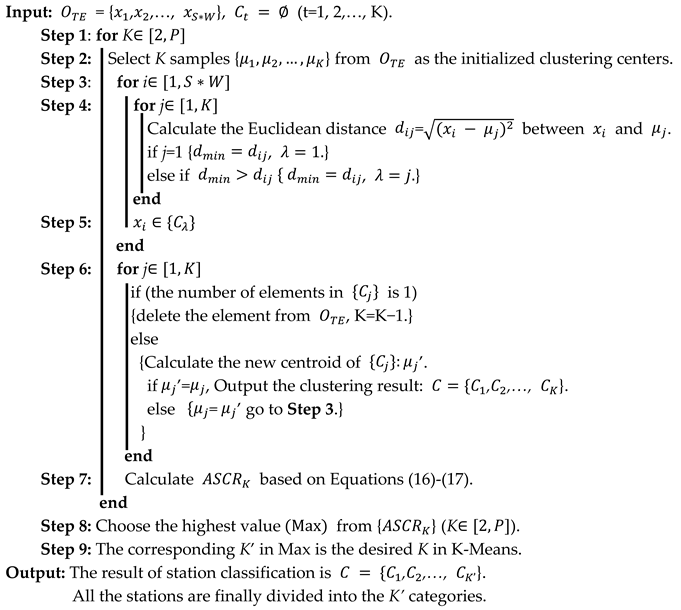 |
2.2. Prediction Block
2.2.1. Spatial Feature Extraction
- (1)
- Inflow
- (2)
- Outflow
- (3)
- Physical Topology
- (4)
- Spatial Feature Fusion
2.2.2. Temporal Feature Extraction
3. Experiments
3.1. Data Description
3.2. Model Configuration
3.3. Evaluation Metrics
3.4. Experiment Results
3.4.1. Classification Results
3.4.2. Prediction Results in the Beijing Metro
3.4.3. Prediction Results in the Xiamen BRT
4. Conclusions
Author Contributions
Funding
Institutional Review Board Statement
Informed Consent Statement
Data Availability Statement
Acknowledgments
Conflicts of Interest
References
- Zhang, Z.; Han, Y.; Peng, T.; Li, Z.; Chen, G. A comprehensive spatio-temporal model for subway passenger flow prediction. ISPRS Int. J. Geo-Inf. 2022, 11, 341. [Google Scholar] [CrossRef]
- Li, X.C.; Peng, Y.Z.; Wu, Z.X.; Chen, Z.W. Short-term forecast of metro station passenger flow based on deep spatial-temporal network. Traffic Transp. 2020, 33, 55–61. [Google Scholar]
- Zhang, J.L. Study of the Short-Term Passenger Flow Prediction in Urban Rail Transit Networks. Ph.D. Thesis, Beijing Jiaotong University, Beijing, China, 29 May 2021. [Google Scholar]
- Zhao, Y.J.; Lin, Y.F.; Zhang, Y.K.; Wen, H.M.; Liu, Y.X.; Wu, H.; Wu, Z.H.; Zhang, S.C.; Wan, H.Y. Traffic inflow and outflow forecasting by modeling intra- and inter-relationship between flows. IEEE Transp. Intell. Transp. Syst. 2022, 23, 20202–20216. [Google Scholar] [CrossRef]
- Bogaerts, T.; Masegosa, A.D.; Angarita-Zapata, J.S.; Onieva, E.; Hellinckx, P. A graph CNN-LSTM neural network for short and long-term traffic forecasting based on trajectory data. Transp. Res. Part C Emerg. Technol. 2020, 112, 62–77. [Google Scholar] [CrossRef]
- Li, S.; Wang, Q.W.; Chen, Y.R.; Qin, J. Prediction of short-time passenger flow on multi-station urban rail based on SAE-ConvLSTM deep learning model. Appl. Res. Comput. 2022, 39, 2025–2031. [Google Scholar]
- Zhang, S.X.; Zhang, J.L.; Yang, L.X.; Yin, J.T.; Gao, Z.Y. GCN-Transformer for short-term passenger flow prediction on holidays in urban rail transit systems. arXiv 2022, arXiv:2203.00007v3. [Google Scholar]
- Ma, C.Q.; Li, P.K.; Zhu, C.H.; Lu, W.B.; Tian, T. Short-term passenger flow forecast of urban rail transit based on different time granularities. J. Chang’an Univ. Nat. Sci. Ed. 2020, 40, 75–83. [Google Scholar]
- Du, C.L.; Li, X.L.; Sun, R.R.; Zhang, P.; Zhu, G.Y. Classification of urban rail station based on passenger flow congestion propagation. J. Beijing Jiaotong Univ. 2021, 45, 39–46. [Google Scholar]
- Wang, H.D.; Ma, H.W. Classification method of urban rail transit stations based on POI. Traffic Transp. 2020, 36, 33–37. [Google Scholar]
- Xia, X.; Gai, J.Y. Classification of urban rail transit stations and points and analysis of passenger flow characteristics based on K-Means clustering algorithm. Modern Urban Transit. 2021, 4, 112–118. [Google Scholar]
- Zhao, Y.; Wang, Y.; Hu, H. Research on clustering method of metro stations based on POI-K_Means. Intell. Comput. Appl. 2022, 12, 114–118. [Google Scholar]
- Yuan, F.T.; Chen, T.J.; Wei, J.B. Research on classification of rail stations based on AFC data. J. Transp. Eng. 2021, 21, 48–52, 57. [Google Scholar]
- Jiang, Y.S.; Yu, G.S.; Hu, L.; Li, Y. Refined classification of urban rail transit stations based on clustered station’s passenger traffic flow features. J. Transp. Syst. Eng. Inf. Technol. 2022, 22, 106–112. [Google Scholar]
- Wang, W.Y.; Liu, J.C.; Yu, Y.D. Research on classification of Xi’an rail transit stations based on land use and population. People’s Public Transp. 2020, 8, 29–33. [Google Scholar]
- Vaswani, A.; Shazeer, N.; Parmar, N.; Uszkoreit, J.; Jones, L.; Gomez, A.N.; Kaiser, L. Attention is all you need. In Proceedings of the 31st Conference on Neural Information Processing Systems (NIPS 2017), Long Beach, CA, USA, 4 December 2017. [Google Scholar]
- Wang, Q.W.; Chen, Y.R.; Liu, Y.C. Metro short-term traffic flow prediction with ConvLSTM. Contral Decis. 2021, 36, 2760–2770. [Google Scholar]
- Tan, Y.F.; Liu, H.X.; Pu, Y.; Wu, X.M.; Jiao, Y.B. Passenger flow prediction of integrated passenger terminal based on K-Means-GRNN. J. Adv. Transp. 2021, 10, 1055910. [Google Scholar] [CrossRef]
- Hinton, G.E.; Osindero, S.; The, Y.W. A fast learning algorithm for deep belief nets. Neural Comput. 2006, 18, 1527–1554. [Google Scholar] [CrossRef]
- Szegedy, C.; Liu, W.; Jia, Y.Q.; Sermanet, P.; Reed, S.; Anguelov, D.; Erhan, D.; Vanhoucke, V.; Rabinovich, A. Going deeper with convolutions. In Proceedings of the IEEE Conference on Computer Vision and Pattern Recognition (CVPR 2015), Boston, MA, USA, 8–10 June 2015. [Google Scholar]
- He., K.M.; Zhang, X.Y.; Ren, S.Q.; Sun, J. Deep residual learning for image recognition. In Proceedings of the IEEE Conference on Computer Vision and Pattern Recognition (CVPR 2016), Las Vegas, NV, USA, 26 June–1 July 2016. [Google Scholar]
- Wang, J.X.; Wang, R.; Zeng, X. Short-term passenger flow forecasting using CEEMDAN meshed CNN-LSTM-attention model under wireless sensor network. IET Commun. 2022, 16, 1253–1263. [Google Scholar] [CrossRef]
- Yang, J.; Dong, X.; Jin, S. Metro passenger flow prediction model using attention-based neural network. IEEE Access 2020, 8, 30953–30959. [Google Scholar] [CrossRef]
- Xue, G.; Liu, S.F.; Ren, L.; Ma, Y.C.; Gong, D.Q. Forecasting the subway passenger flow under event occurrences with multivariate disturbances. Expert Syst. Appl. 2022, 188, 116057–116070. [Google Scholar] [CrossRef]
- Liu, L.J.; Chen, R.C.; Zhu, S.Z. Impacts of weather on short-term metro passenger flow forecasting using a deep LSTM neural network. Appl. Sci. 2020, 10, 2926. [Google Scholar] [CrossRef]
- Wu, Y.K.; Tan, H.C.; Qin, L.Q.; Ran, B.; Jiang, Z.X. A hybrid deep learning based traffic flow prediction method and its understanding. Transp. Res. Part C Emerg. Technol. 2018, 90, 166–180. [Google Scholar] [CrossRef]
- Zhang, J.; Chen, F.; Cui, Z.; Guo, Y.; Zhu, Y. Deep learning architecture for short-term passenger flow forecasting in urban rail transit. IEEE Transp. Intell. Transp. Syst. 2021, 22, 7004–7014. [Google Scholar] [CrossRef]
- Chen, L.; Liu, L.J.; Yuan, L. Multi-head attention mechanism for multi-station passenger flow prediction. In Proceedings of the 2022 International Symposium on Design Studies and Intelligence Engineering (DSIE2022), Hangzhou, China, 29–30 October 2022. [Google Scholar]
- The Most Authoritative Route Map of Xiamen BRT. Available online: http://xm.bendibao.com/traffic/20161011/51844.shtm (accessed on 29 July 2022).
- Siwar, Y.; Salwa, S.; Mourad, Z. Wavelet extreme learning machine and deep learning for data classification. Neurocomputing 2022, 470, 280–289. [Google Scholar]
- Emanuel, G.; Rodrigo, C. Chebyshev wavelet analysis. J. Funct. Spaces 2022, 2022, 5542054. [Google Scholar]
- Gökalp, Ç.; Bülent, G.E.; Ahmet, H.Y. Prediction of glioma grades using deep learning with wavelet radiomic features. Appl. Sci. 2020, 10, 6296. [Google Scholar]
- Yu, X.J.; Liu, Y.R.; Sun, Z.M.; Qin, P. Wavelet-based ResNet: A deep-learning model for prediction of significant wave height. IEEE Access 2022, 10, 110026–110033. [Google Scholar] [CrossRef]
- Emanuel, G.; Sergei, S. Fractional-wavelet analysis of positive definite distributions and wavelets on D′(C). In Engineering Mathematics II: Algebraic, Stochastic and Analysis Structures for Networks, Data Classification and Optimization; Sringer Proceedings in Mathematics & Statistics; Springer International Publishing: New York, NY, USA, 2016; Volume 179, pp. 337–353. [Google Scholar]
- Indumathi, J.; Kaliraj, V. Petite term traffic flow prediction using deep learning for augmented flow of vehicles. Concurr. Eng. 2022, 30, 214–224. [Google Scholar] [CrossRef]
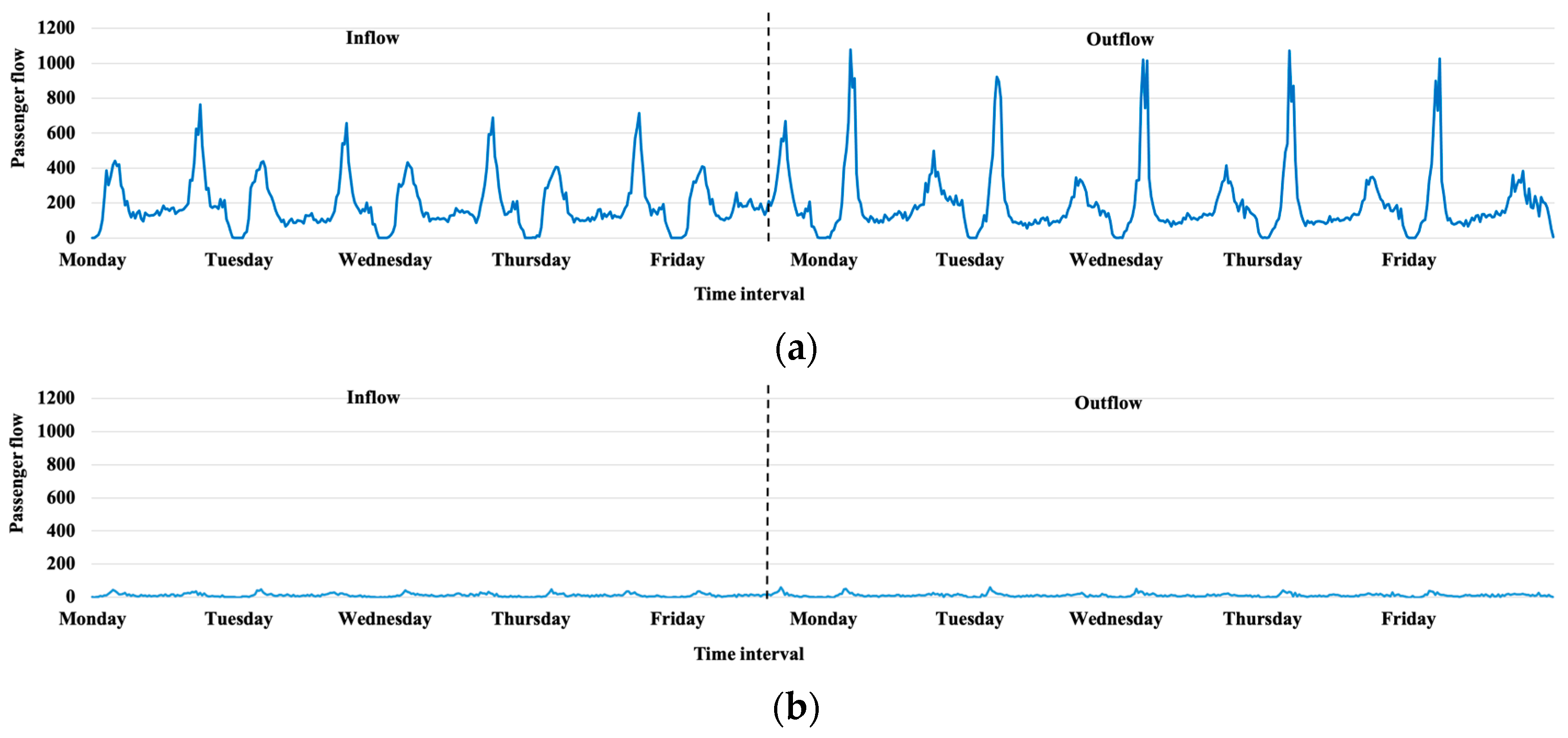
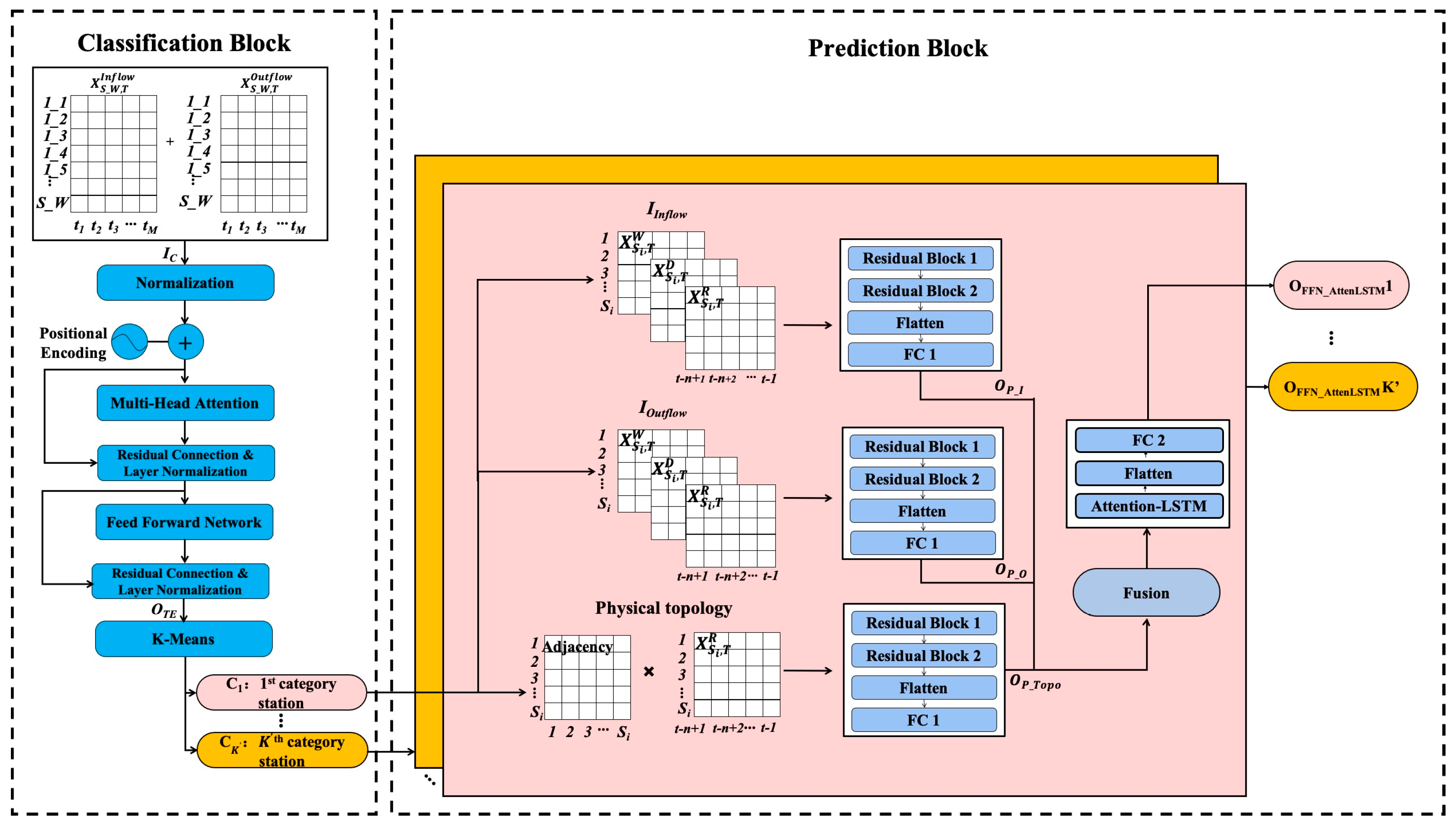

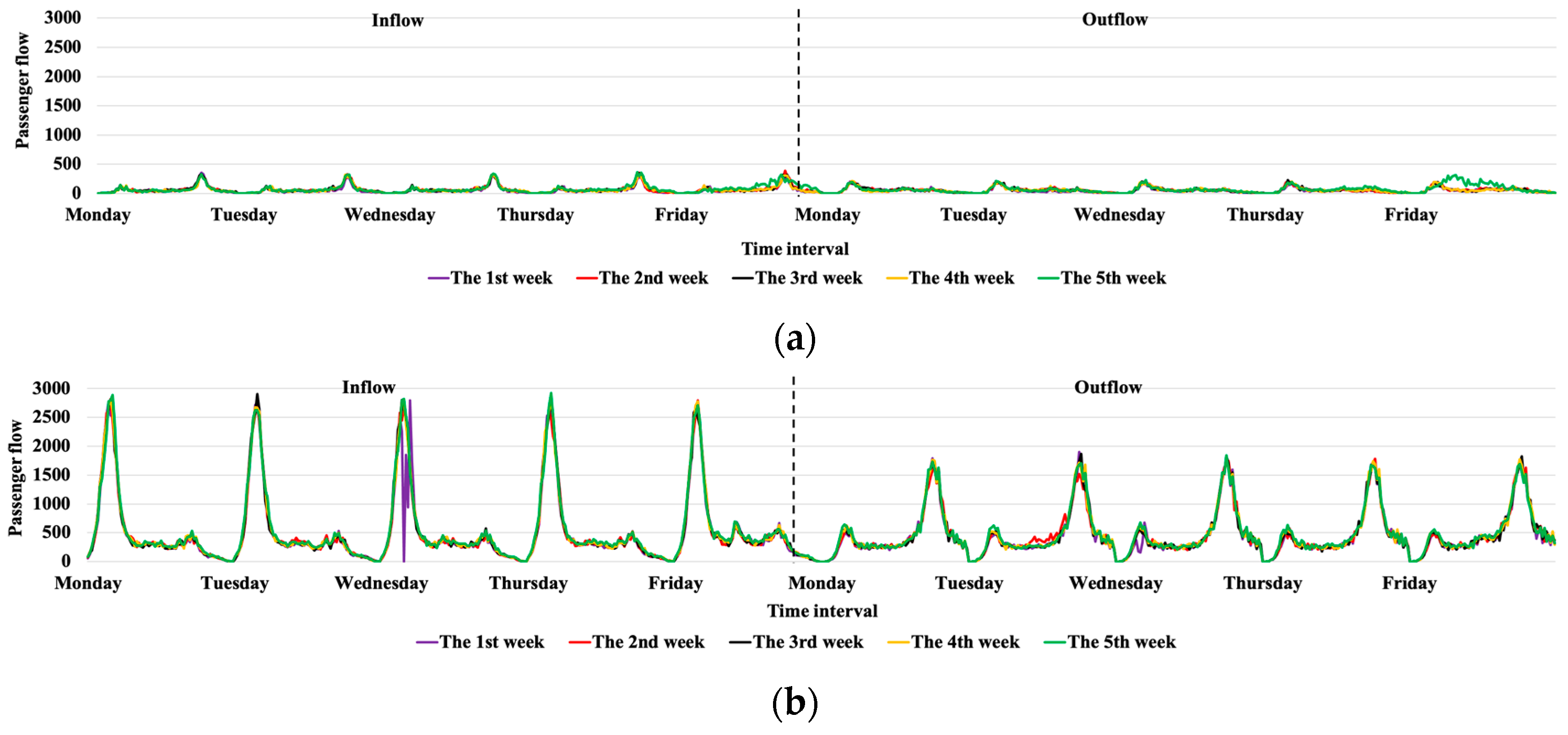
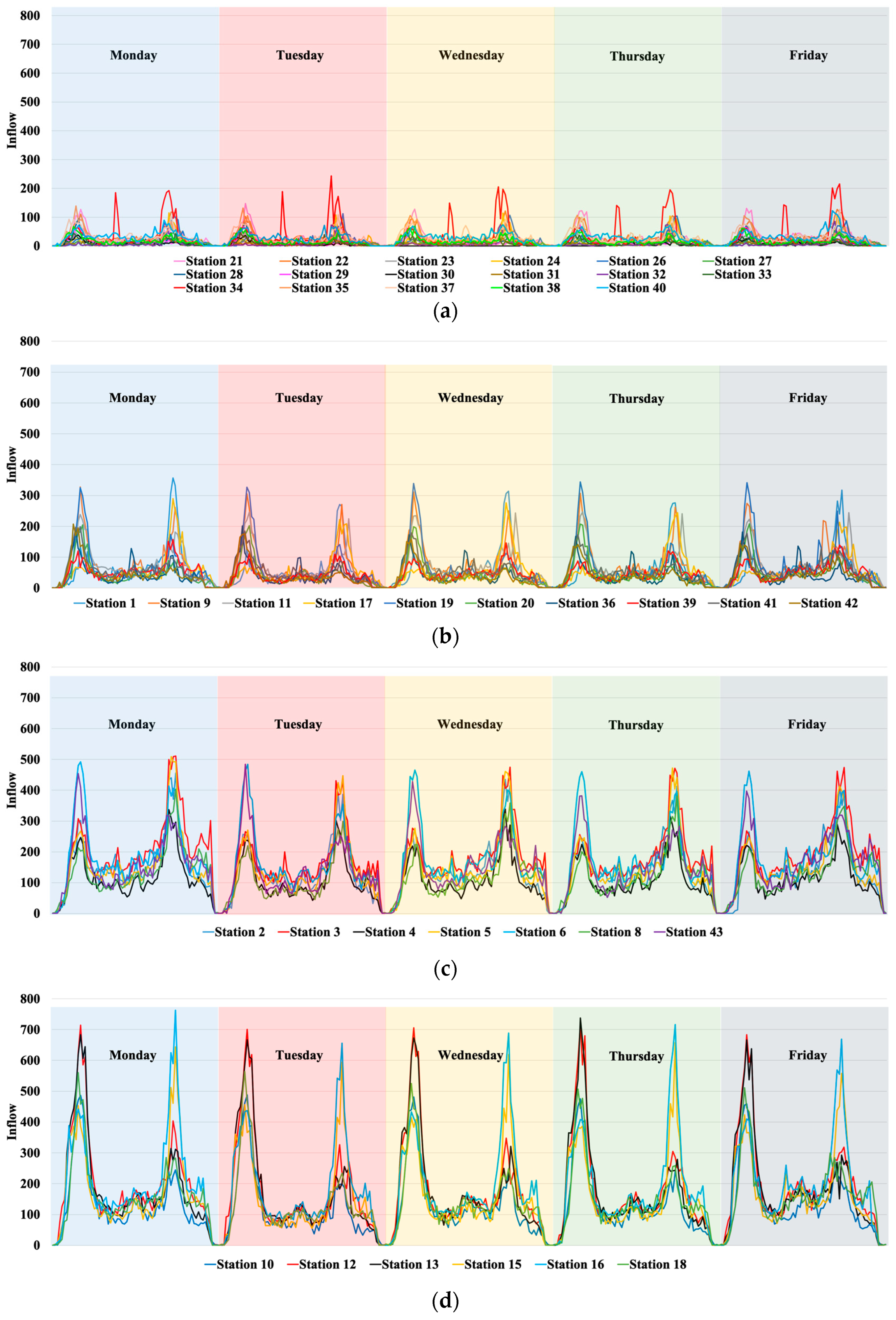


| Description | Beijing Metro | Xiamen BRT | ||||
|---|---|---|---|---|---|---|
| Train Timespan | 29/02/2016–04/03/2016 07/03/2016–11/03/2016 14/03/2016–18/03/2016 21/03/2016–25/03/2016 | 04/03/2019–08/03/2019 11/032019–15/03/2019 18/03/2019–22/03/2019 25/03/2019–29/03/2019 | ||||
| Test Timespan | 28/03/2016–01/04/2016 | 01/04/2019–05/04/2019 | ||||
| Week Number | 5 | 5 | ||||
| Day Number | 25 | 25 | ||||
| Daily Service Hours | 5:00 a.m.–11:00 p.m. | 5:00 a.m.–11:00 p.m. | ||||
| Time Interval | 10 min | 15 min | 30 min | 10 min | 15 min | 30 min |
| DS | 108 | 72 | 36 | 108 | 72 | 36 |
| Total DS | 2700 | 1800 | 900 | 2700 | 1800 | 900 |
| Line Number | 17 | 8 | ||||
| Station Number | 276 | 44 | ||||
| Parameters | Transformer Encoder | K-Means |
|---|---|---|
| d_model | 2 × DS, 2 × days | |
| Number of heads | 2 | |
| K | 2–10 | |
| Optimizer | Adam | |
| Learning rate | 0.00004 | |
| Parameters | Inflow | Outflow | Physical Topology | Attention LSTM |
|---|---|---|---|---|
| Kernel Size | 3 × 3 | 3 × 3 | 3 × 3 | |
| Residual Block 1 | 32 filters | 32 filters | 32 filters | |
| Residual Block 2 | 64 filters | 64 filters | 64 filters | |
| Batch Size | 64 | 64 | 64 | 64 |
| Activation Function | Relu | Relu | Relu | Linear |
| Number of Neurons in FC 1 | ||||
| Number of Neurons in FC 2 | ||||
| Number of Layers | 1 | |||
| Number of Neurons (Neu) | 128 |
| K | ASCR | |||||
|---|---|---|---|---|---|---|
| Xiamen BRT | Beijing Metro | |||||
| 10 min | 15 min | 30 min | 10 min | 15 min | 30 min | |
| 2 | 0.8 | 0.8 | 0.795 | 0.794 | 0.797 | 0.797 |
| 3 | 0.8 | 0.795 | 0.795 | 0.8 | 0.797 | 0.797 |
| 4 | 0.8 | 0.8 | 0.8 | 0.787 | 0.798 | 0.798 |
| 5 | 0.8 | 0.795 | 0.795 | 0.791 | 0.796 | 0.795 |
| 6 | 0.8 | 0.795 | 0.795 | 0.782 | 0.792 | 0.793 |
| 7 | 0.789 | 0.790 | 0.8 | 0.786 | 0.791 | 0.790 |
| 8 | 0.794 | 0.785 | 0.8 | 0.785 | 0.789 | 0.792 |
| 9 | 0.8 | 0.795 | 0.795 | 0.781 | 0.788 | 0.790 |
| 10 | 0.784 | 0.790 | 0.795 | 0.781 | 0.788 | 0.790 |
| No. | Station Name | No. | Station Name | No. | Station Name | No. | Station Name |
|---|---|---|---|---|---|---|---|
| 1 | 1st Wharf | 12 | Caitang | 23 | Dongzhai | 34 | Pantu |
| 2 | Kaihe Intersection | 13 | Jinshan | 24 | Tiancuo | 35 | Binhai Xincheng (Xike) Junction |
| 3 | Sibei | 14 | Municipal Administrative Service Center | 25 | Xiamen North Railway Station | 36 | Guanxun |
| 4 | Douxi Road | 15 | Shuangshi Middle School | 26 | Institute of Technovation | 37 | Light Industry and Food Park |
| 5 | Ershi | 16 | Xianhou | 27 | Gaoqi Airport | 38 | Sikouzhen |
| 6 | Jinbang Park | 17 | Airport Terminal 4 | 28 | Fenglin | 39 | Industrial Zone |
| 7 | Railway Station | 18 | Tan Kah Kee Stadium | 29 | Dong’an | 40 | 3rd Hospital |
| 8 | Lianban | 19 | Chengyi University College | 30 | Houtian | 41 | Chengnan |
| 9 | Longshanqiao | 20 | Huaqiao University | 31 | Dongting | 42 | Tong’an Junction |
| 10 | Wolong Xiaocheng | 21 | University Town | 32 | Meifeng | 43 | Hongwen |
| 11 | Dongfang Shanzhuang | 22 | Chinese Academy of Sciences | 33 | Caidian | 44 | Qianpu Junction |
| Categories | Station No. | Number | Passenger Flow Volume |
|---|---|---|---|
| 1 | 21, 22, 23, 24, 26, 27, 28, 29, 30, 31, 32, 33, 34, 35, 37, 38, 40 | 17 | Small |
| 2 | 1, 9, 11, 17, 19, 20, 36, 39, 41, 42 | 10 | Medium |
| 3 | 2, 3, 4, 5, 6, 8, 43 | 7 | Medium |
| 4 | 10, 12, 13, 15, 16, 18 | 6 | Large |
| No. | Deleted Station | Time Interval | ||
|---|---|---|---|---|
| 10 min | 15 min | 30 min | ||
| 3 | Sibei | ✓ | ||
| 7 | Railway Station | ✓ | ✓ | ✓ |
| 14 | Municipal Administrative Service Center | ✓ | ✓ | |
| 25 | Xiamen North Railway Station | ✓ | ✓ | ✓ |
| 44 | Qianpu Junction | ✓ | ✓ | ✓ |
| Time Interval | Prediction Mode | Metrics | ||
|---|---|---|---|---|
| MAE | RMSE | WMAPE | ||
| 10 min | Prediction (with classification) | 17.2781 | 29.6929 | 9.668% |
| Prediction (w/o classification) | 17.6344 | 29.6219 | 9.911% | |
| 15 min | Prediction (with classification) | 22.1919 | 37.9693 | 8.269% |
| Prediction (w/o classification) | 23.0008 | 38.7386 | 8.589% | |
| 30 min | Prediction (with classification) | 32.5245 | 58.1694 | 6.120% |
| Prediction (w/o classification) | 34.1360 | 60.1340 | 6.428% | |
| Time Interval | Prediction Mode | Metrics | ||
|---|---|---|---|---|
| MAE | RMSE | WMAPE | ||
| 10 min | Prediction (with classification) | 9.2998 | 15.6633 | 18.58% |
| Prediction (w/o classification) | 9.3990 | 16.0151 | 18.80% | |
| 15 min | Prediction (with classification) | 12.7193 | 22.2835 | 16.29% |
| Prediction (w/o classification) | 12.7559 | 22.3270 | 16.33% | |
| 30 min | Prediction (with classification) | 23.0463 | 46.2256 | 14.26% |
| Prediction (w/o classification) | 22.6983 | 47.2300 | 14.03% | |
Disclaimer/Publisher’s Note: The statements, opinions and data contained in all publications are solely those of the individual author(s) and contributor(s) and not of MDPI and/or the editor(s). MDPI and/or the editor(s) disclaim responsibility for any injury to people or property resulting from any ideas, methods, instructions or products referred to in the content. |
© 2023 by the authors. Licensee MDPI, Basel, Switzerland. This article is an open access article distributed under the terms and conditions of the Creative Commons Attribution (CC BY) license (https://creativecommons.org/licenses/by/4.0/).
Share and Cite
Liu, L.; Wu, M.; Chen, R.-C.; Zhu, S.; Wang, Y. A Hybrid Deep Learning Model for Multi-Station Classification and Passenger Flow Prediction. Appl. Sci. 2023, 13, 2899. https://doi.org/10.3390/app13052899
Liu L, Wu M, Chen R-C, Zhu S, Wang Y. A Hybrid Deep Learning Model for Multi-Station Classification and Passenger Flow Prediction. Applied Sciences. 2023; 13(5):2899. https://doi.org/10.3390/app13052899
Chicago/Turabian StyleLiu, Lijuan, Mingxiao Wu, Rung-Ching Chen, Shunzhi Zhu, and Yan Wang. 2023. "A Hybrid Deep Learning Model for Multi-Station Classification and Passenger Flow Prediction" Applied Sciences 13, no. 5: 2899. https://doi.org/10.3390/app13052899
APA StyleLiu, L., Wu, M., Chen, R.-C., Zhu, S., & Wang, Y. (2023). A Hybrid Deep Learning Model for Multi-Station Classification and Passenger Flow Prediction. Applied Sciences, 13(5), 2899. https://doi.org/10.3390/app13052899







